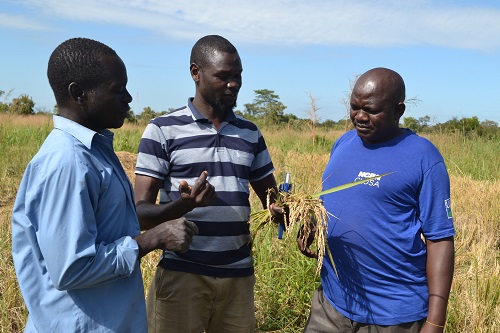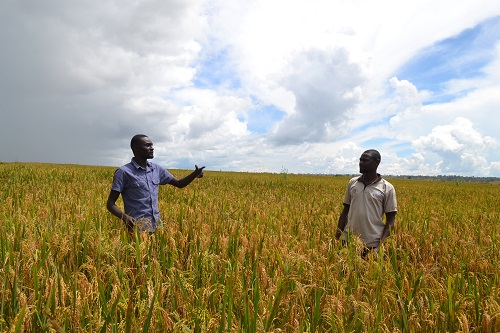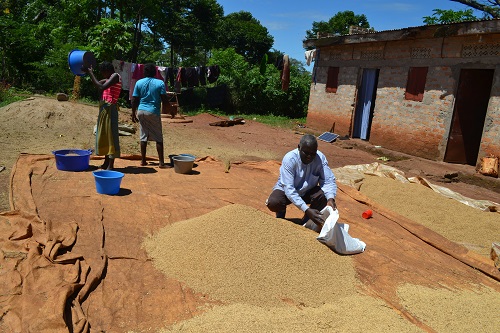How are Ugandan farmers adapting to climate change?
How are Ugandan farmers adapting to climate change?
How are Ugandan farmers adapting to climate change? By abandoning maize for new varieties of rice in response to changing weather patterns - found Isaiah Esipisu in this investigative report from Amuru district in the country’s north.
In Amuru district in the northern part of Uganda, 47 kilometres out of Gulu town, swathes of land under upland rice, pearl millet and the flowery sunn hemp in a place where maize has always been the traditional crop attracts the attention of any visitor in this area.
“This is our new cash cow,” says Dominic Kimara, the farm Manager of Omer Farming Company, which has been growing maize on 5,000 hectares of land but has now turned to 100 percent rice production.
“Until 2016, we were growing maize on this farm,” says the manager. “But we discovered that rainfall patterns were changing, and so we had to look for an alternative crop that would suit the ever changing climatic conditions.”

Farmers examine the upland rice crop.
A larger trend of crop-switching
Experts from the National Agriculture Organisation (NARO) have reported that in the past three years, many farmers in Uganda have abandoned maize to concentrate on rice with most of them opting for upland rice instead of irrigated paddy rice.
The latest agriculture survey report by NARO, the Ugandan government-owned research organisation, indicates that more than 50 percent of rice grown in the country is now coming from the uplands. Rice consumption – especially in urban areas – has increased considerably.
“When I was growing up, rice used to be a Christmas meal because it was a rare one,” notes Robert Kawuki as he enjoyed a rice meal for lunch at the NARO canteen in Namulonge area. “But today, farmers have embraced it, and so people can enjoy it any time, both in the upcountry and in urban areas,” he says.
Although upland rice is more sensitive to climate stress than irrigated paddy rice, farmers in Northern Uganda say that latest varieties grown in the area have proven to be more profitable than the maize crop.
“Most of the varieties grown by these farmers are the ones we released in 2015, and were bred mainly for drought tolerance, fast maturation and pest and disease resistance, but most importantly, because they are high yielding,” says Dr Jimmy Lamo, the Principal Research Officer working with NARO as the Head of Rice and Maize Research Programme.
“According to our latest survey, out of a total of 150,000 hectares under rice production in the country, 90,000 hectares is grown in the uplands without any form of irrigation,” says Dr Lamo.
Dr Lamo earned his PhD from the University of KwaZulu-Natal, South Africa, for breeding some of the varieties under support from the Alliance for a Green Revolution in Africa (AGRA).
He notes that crop-switching, mainly from maize to upland rice, is a way of responding to the new trends of rainfall patterns in some parts of the country.

Dominic Kimara (left) with James Ekebu of NARO in a rice field, northern Uganda.
New farming practices aim to reduce fertiliser use
In Amuru, Omer Company has adopted climate smart farming techniques, and local farmers are following suit.
“We grow pearl millet, but it is not for human food. It is for soil health,” he says.
When the millet starts flowering, the crop is rolled flat on the ground and left to decompose. The same is done for sunn hemp, which is a leguminous plant with rich soil nutrients. “When they decompose, these two crops fix a lot of nitrogen into the soil. So when we finally plant rice, there is absolutely no need of applying fertilisers,” said Mr Kimara.
The company practices shifting cultivation, whereby when rice is growing on one part of the farm, there is either pearl millet or sunn hemp growing in the other half, waiting to be rolled down for the next season planting.
About 1,700 farmers in the neighbouring villages have also started growing rice instead of maize and some of them have adopted the no till system.
“Upland rice farming is much better for most of us because the company buys most of it from us at a good price, and as well, we use it to feed our children,” says Regina Kisembo from Luwila village in Amuru. She is one of the farmers who have been contracted by Omer Company as out growers. “The company loans us seed to be paid upon harvest, and they keep training us on upland rice production. They also advise us on which varieties to plant in a given season depending on the weather forecast,” she says.

Rice drying at the homestead, northern Ugandan village.
New rice varieties are a game-changer
According to Dr Lamo, NARO released six upland rice varieties known as NamChe (Namulonge Mchele), which have since become a game-changer. “We have some varieties that mature in just 90 days, and farmers prefer those during short rainy seasons, then they can plant other varieties that mature in four to five months during the long rainy season,” he says.
Many upland rice varieties, earlier introduced in the country, were late maturing and did not have preferred cooking qualities. Later, more newly introduced lines were evaluated and released. These varieties had been generated through inter-specific crossing involving Oryza glaberrima and Oryza sativa. The new genotypes were called the ‘New Rice for Africa’ (Nerica).
Nerica was actually a cross between locally adopted African rice with high yielding Asian rice varieties and was introduced on the African continent in 1996.
Nerica varieties were resistant to many diseases but still sensitive to drought stress and new diseases, especially brown spot disease and narrow leaf spot disease. Besides, these varieties were not aromatic, which is a major concern for Ugandan farmers and rice consumers in the country.
To develop NamChe, a total of 191 different rice varieties from major rice breeding centres were evaluated. Of the 191 materials, 77 were O. sativa indica comprising 45 from African Rice Centre (ARC), 15 lines from International Rice Research Institute (IRRI), 13 from Mali, three from Uganda, and one from China.
The varieties were then crossed with Nerica, where the results were evaluated based on yields, tolerance to climatic stress, tolerance or resistance to emerging diseases, cooking qualities among other desirable traits. Out of the crosses, scientists ended up with only six varieties that had most of the desired traits and they were named NamChe 1, 2, 3, 4, 5, and 6.
According to Kimara, the fast maturing NamChe varieties (90 days) yield up to two tons per acre, while the late maturing (120 days) can yield up to 3.5 tonnes per acre.
“We are happy with this crop. The only challenge is the poor road infrastructure, which makes it difficult for trucks to come over for the crop to be transported to Kampala and elsewhere,” says the farm manager.
Image above right: Dominic examining the leguminous sunn hemp crop. All images courtesy Isaiah Esipisu.
This article was produced as part of a series on use of climate information and responses to climate risk in Africa by the Weather and Climate Information Services for Africa (WISER) programme.
